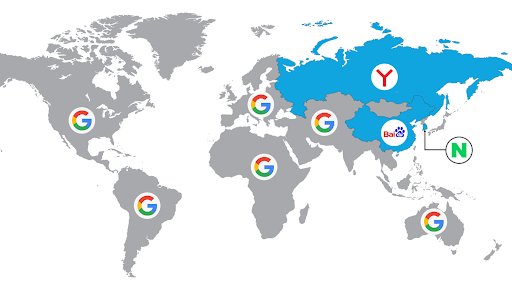Effective global SEO is a must for streaming services that want to grow their audience and brand internationally. But there’s a lot that can go wrong when you’re trying to optimize for global markets. Without the right strategy, you’ll continue to lose valuable international growth.
Search is the top channel people across the world use discover new content and new platforms. Beyond traditional search engines, social media and other channels are also being used worldwide. In saturated markets, getting your brand in front of your global customers is more complex than ever.
On top of all the challenges marketers face domestically – like search engine algorithm updates, indexing issues, and domestic competitors – international marketers have to contend with hurdles unique to the global SEO landscape.
So if you’re not reaching the organic acquisition rates you expect, you’re not alone. Here are the top 3 reasons your global SEO isn’t working (and what to do about it).
HOW MARKETING & TRANSLATION AGENCIES GET GLOBAL SEO WRONG
When companies go international, they often work with a domestic marketing agency or translation agency (or both) to support their digital marketing. But international SEO is a beast all its own. And it’s one neither type of agency is well equipped to tackle.
Why? Translation agencies don’t have the SEO expertise to really optimize web properties effectively. Or to instruct their clients on the nitty-gritty details that can make or break in-country SEO success. And domestic marketing agencies? They don’t have the international expertise (or in-market network) to understand the country’s linguistic, cultural, and technical landscapes. And they therefore can’t create a truly authentic experience for local audiences.
So if you’re working with either type of agency, it’ll likely fall on you to figure out what’s tanking your international traffic.
REASON #1: MISCONFIGURING THE TECHNICAL SETUP
Technical setup for global SEO is complex. Any one of several technical issues can, at best, limit how much you can optimize for each of your target markets. And at worst, prevent you from showing up on in-country SERPs at all.
IN-MARKET PAGE LOAD SPEED
If your site is slow to load in-country, you’ll be penalized for it. And there’s a lot that can impact page load speed. Your CMS, plugins, images, and themes can all slow you down. With internet bandwidth varying between markets, “heavier” elements can mean your website is slower to load in other countries than it is domestically.
Where your website is hosted matters, too. If you’re using a domestic host, that can reduce site performance in other markets, like those in APAC. The same goes even for different elements on the page. If a service (like a font, map, or plugin) is hosted far from your target country, that may increase overall site load speed. Or, in some cases, prevent the service from loading altogether.
GLOBALLY LIMITED TECH STACK
The way your CMS, plugins, and themes are structured may entirely prevent you from optimizing your site for another market. At a minimum, you’ll need to make sure your site tech stack allows you to easily modify basic SEO elements: page copy, title tags, URLs, meta descriptions, internal links, and language tags.
If you use a website localization plugin, make sure it’s built for SEO. Because of the way many of them store and serve up content, your localized site may not get indexed at all.
Finally, watch out for tech that requires your localized pages to have a one-to-one relationship with existing English pages. This will significantly reduce your ability to customize for each market.
MISSING OR INCORRECT LANGUAGE/REGION TAGS
Language tags signal to search engines what language a piece of content is in and what region it’s for. These have a big impact on content with multiple language versions. If, for instance, your French content is shown to a search engine user in Germany, that’s a bad user experience. And your target customers will opt to visit a competitor instead.
The biggest mistakes marketers make here are either not using these tags at all or implementing them incorrectly.
USER-UNFRIENDLY GEOTARGETING
Automatically geotargeting users based on perceived language makes for a bad user experience. And when you have several languages on your site, it’s more difficult for search engines to crawl and index all your content. (Google cautions against automatic geotargeting for this reason.) The result? Poor SEO performance and more users bouncing from your site.
Instead, optimize for your key international markets, implement your language/region tags correctly, and let search engines (and your audience) choose which content to access. Also be sure to give your visitors a way to access other language/region versions of your site.
(An exception to this rule: If you’re streaming content that, for legal reasons, should not be accessible by users in a particular market.)
MISSING EVENT & CONVERSION TRACKING
Your marketing performance is only as good as your data. Event and conversion tracking are essential to measuring the actions that matter for your audience. Google Analytics 4 allows you to set up events in the platform, and manually choose which events you’d like to count as conversions.) So it’s important to make sure that you’ve not only set up events/conversions for your site, but also that they’ll give you the information you need to really understand how local users are engaging with your content – and whether they’re showing signs of subscribing.
Additionally, since brand awareness and adaptation will vary between markets, you’ll want to set up country-specific event or conversion actions. This might mean setting different metrics for regions that you may already be saturated in versus regions where you’re wanting to dial up customer acquisition.
REASON #2: RELYING ON TRANSLATED CONTENT TO DRIVE RESULTS
First, some important context: translation is, generally speaking, word-for-word interpretation of text. Marketing localization, in contrast, accounts for the context of your business, service, and the local market you’re speaking to.
So relying on translation makes sense for user guides, simple descriptions, or other clear-cut, straightforward assets. But for international marketing content, translation is only a tactic – it’s not the end goal.
KEYWORD TRANSLATION INSTEAD OF KEYWORD RESEARCH
For global SEO, one of the most painful mistakes marketers (and their agencies) make is translating keywords.
Imagine you’ve had your strongest performing domestic keywords translated for your target market. Then, you go through the painstaking process of implementing them across your various pages. Integrating them into your title tags, meta descriptions, headers, body copy, URLs. Only to find your localized website isn’t driving the acquisitions you expected. Or just low-value subscribers.
Translating keywords will get you a list of terms, but there’s no guarantee that there’s sufficient search volume behind them – or that the translated terms signal the same intent in your target country as they do domestically. Even some countries with relatively low English proficiency use English words (and variants) for specific items or services, which would be missed entirely by keyword translation.
Keyword research is just as important for other countries as it is for your domestic marketing. Every country has its own nuances that non-native speakers just won’t be aware of.
For your global SEO to be successful, you need to work with in-country SEO experts who can perform in-language keyword research. And who can identify the perfect keywords that check all the boxes for your brand, your offering, in-country keyword volume, and search intent.
MASS TRANSLATION OF WEBSITE CONTENT
Again, for global marketing to be effective, translation is a tactic, not a goal. Mass translating your website content without a growth strategy will exclude many opportunities for optimization and acquisition. (And it’ll waste a lot of your budget.) This makes for an irrelevant experience for your audience, limiting the success of your localized site.
Instead, focus on localizing the content that’s important to the in-country user journey. Identify which content on your site has SEO value from the start. Then make sure each of those pages has keywords assigned.
From there, follow best practices for keyword placement, integrating your keywords naturally throughout your content. When working in other languages, you’ll need to be conscious of character limitations for title tags and meta descriptions so they don’t get truncated.
And don’t forget about your URLs. Many international marketers keep their URLs in English, negatively impacting clickthrough rates, user experience, and overall performance.
GENERIC TRANSLATION INSTEAD OF EXPERT LOCALIZATION
All content is not created equally. Domestically, you wouldn’t have someone unfamiliar with the streaming industry write your marketing copy. It’s not so much that the content wouldn’t be accurate. It’s that it wouldn’t be engaging. It wouldn’t convey your brand’s unique positioning. And it wouldn’t convert visitors into high-value customers that are loyal to your brand and content library.
The same principle applies for your international content, too. When adapting your website for another country, you don’t need just translation. You need marketing localization – adaptation of your content with an eye focused on your brand, goals, acquisition efforts, and the local market context. And that localization needs to be done by someone masterful at the local language, the subject matter, and SEO.
So be careful who you work with. And whoever you choose, give them the information they need to produce content that meets user expectations – no matter where they are in the world. Make sure you brief them on the purpose, target audience, and tone of voice. This will make for more nuanced, targeted, engaging, and optimized content.
REASON #3: TARGETING A LANGUAGE RATHER THAN A MARKET
Every market is different – even if it uses a common language. Approaching each one in the same way is a recipe for disaster.
IGNORING TERMINOLOGY DIFFERENCES BETWEEN MARKETS
Keyword traffic for a service can vary greatly between markets that have the same language – even English markets.
Targeting a language rather than a market means overlooking the vital differences that can mean success or failure for your global SEO strategy. You can’t assume how people in different markets are searching and what terminology they’re using. But by targeting your audience at the country level, you can ensure you capture the most relevant, qualified traffic in each market.
OVERLOOKING LOCAL COMPETITORS & CONTEXT
Your competition will likely vary between markets. And targeting a language (rather than a market) means you won’t be in a position to tailor your strategy enough at the local level to overtake them.
Instead, by looking at each country or market’s unique context, you’ll be able to analyze competitor tactics, content, and keywords. Then use your findings to adapt your strategy or uncover new opportunities.
There may also be circumstances that are out of your control happening only in one market – for instance, a well-established brand in an entirely different industry that has your same brand name or colors. Without a localized SEO strategy for that market, it will be much more difficult for you to address these types of country- or region-level issues.
OVERLOOKING LOCAL PLATFORMS
In most markets, Google is king. But for some countries – like South Korea and Japan – there are local search engines that answer consumers’ burning questions. Make sure you’re targeting users on the platforms they use. (And that you have the resources to pursue them there.)

FINAL THOUGHT
For streaming companies, SEO isn’t just a technical effort—it’s a cost-effective growth channel that sits at the heart of a localized digital footprint. A strong global SEO strategy is essential for creating a seamless local brand experience, enabling brands to connect authentically with audiences worldwide.
SEO drives both acquisition and retention, making it a cornerstone for growth in the competitive streaming industry. By tailoring content to local search behaviors and preferences, streaming platforms can boost customer acquisition rates, increase engagement, and foster long-term viewer loyalty – ultimately reducing churn, too.
Getting low engagement in key markets? From SEO audits to SEO-driven, in-language copywriting and beyond, we’re here to help. Get in touch now.







